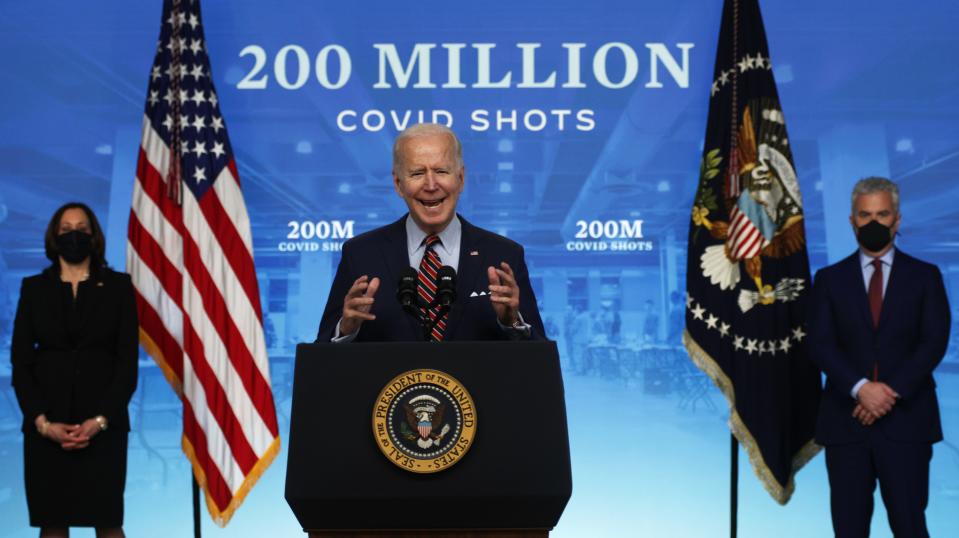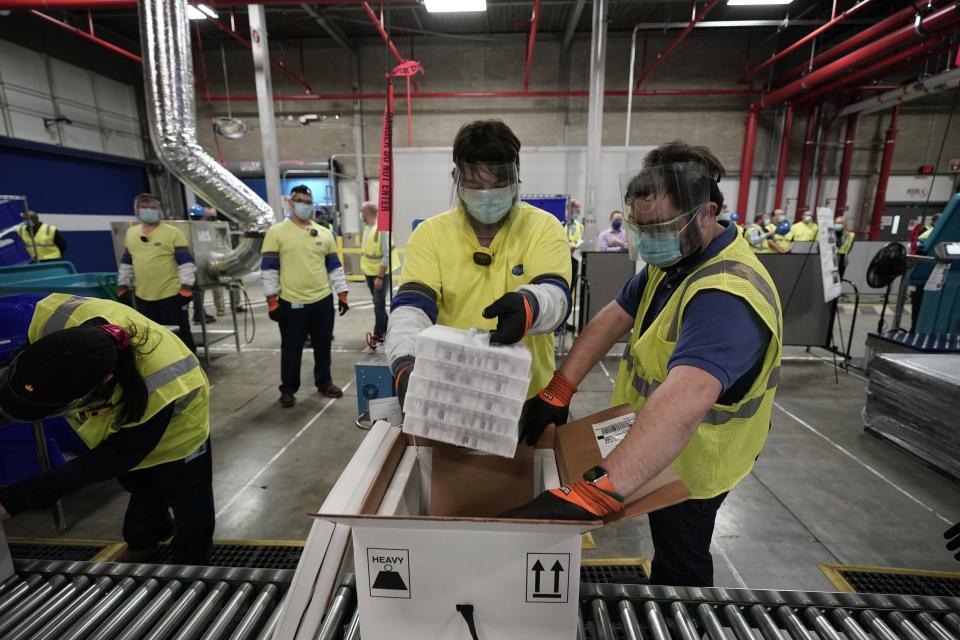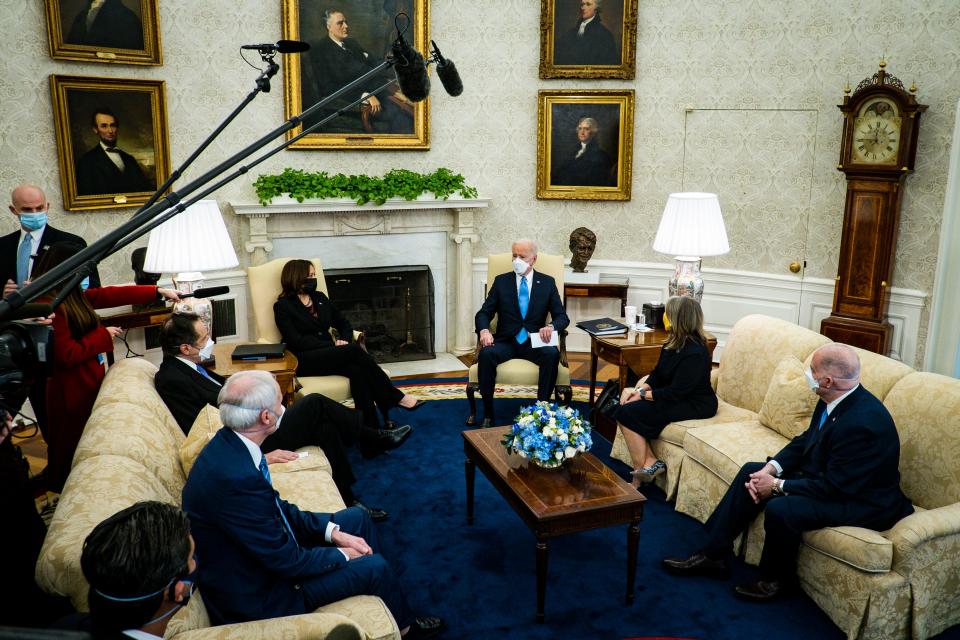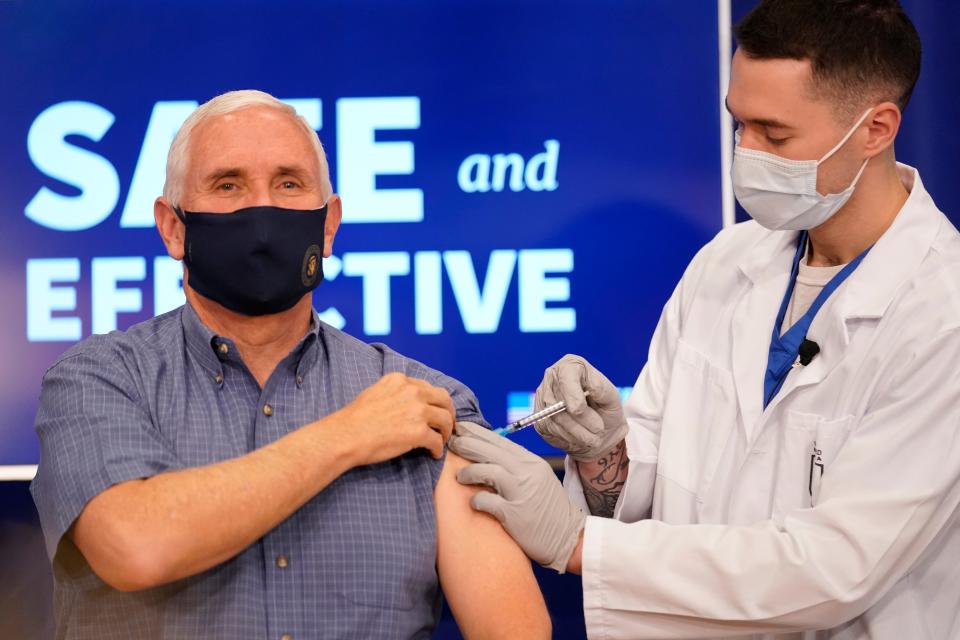Biden blazed past his vaccine target for the first 100 days. Does the Trump administration deserve credit too?
- Oops!Something went wrong.Please try again later.
- Oops!Something went wrong.Please try again later.
WASHINGTON – When President Joe Biden announced last week that he had shattered his increased goal of administering 200 million COVID-19 vaccine shots in his first 100 days in office, he described it as both a milestone for his administration and a "reminder of what we can accomplish when we pull together as one people to a common goal."
Biden, who has faced questions about whether he credits former President Donald Trump enough for reaching a pivotal moment in the pandemic, instead highlighted his team of health experts, vaccination site volunteers, members of the military, state and local health departments, and front-line health care workers behind the Herculean effort.
His careful wording – which casts the sprint to vaccinate as a collective effort –underscores a months-long debate over who deserves credit, something health experts say belongs to both administrations: Trump for aggressively developing a vaccine and Biden for rolling it out. But it's Biden whose political fortunes remain tightly bound to getting the country back to normal, a task that may get tougher as the administration enters a new phase of trying to vaccinate harder-to-reach populations and skeptics.
As Biden marks his first 100 days in office this week with a joint address to Congress, he is expected to tout how his administration has turned the tide on a coronavirus pandemic that has killed more than half a million Americans and left millions more jobless. Part of that success is a vaccine campaign that has operated at a breakneck pace in which more than half of all American adults have received at least one COVID-19 vaccine shot, an achievement that seemed inconceivable last summer as the virus wreaked havoc across the country.
"Getting enough vaccines into the population is inextricably linked to how the economy will do. The growth rate this year and the number of people working and their wages will all be linked to how many shots are in arms," said Ben LaBolt, a former White House and campaign adviser to President Barack Obama. "They know that the president's success will be judged in large part based on how effective the vaccine distribution is and all indications so far is that it's exceeding expectations."
But a look at the vaccine's development and distribution during Biden's first 100 days shows giving credit to either administration is more nuanced: While Trump made a high-stakes gamble that led to record-breaking vaccine development before Inauguration Day, the Biden administration formalized a national strategy that helped the nation's patchwork of health systems execute a vaccination rate of more than 3 million shots a day.

An ambitious target or safe pledge?
Six days before he took office, Biden announced a seemingly ambitious goal of immunizing 100 million Americans within his first 100 days in office. Based on the projected vaccine supplies and pace when he took office, it was a safe pledge.
On Inauguration Day, clinics and mass-immunization sites delivered 1 million shots in the arms of Americans. It was an “instance of underpromising in order to overdeliver,” said Dr. Amesh Adalja, a senior scholar at Johns Hopkins University Center for Health Security.
Biden later revised his goal to 200 million shots in 100 days, a goal the nation met on his 92nd day in office, Biden said Wednesday as he urged businesses to give workers paid leave to get vaccinated. Biden is expected to deliver remarks on the nation's COVID-19 response Tuesday as the Centers for Disease Control and Prevention unveils new guidance for Americans who have been fully vaccinated.
The number of doses was largely based on contracts negotiated by the Trump administration’s all-in vaccine development strategy, called Operation Warp Speed. Devised in the early days of the pandemic, the effort extended agreements to eight manufacturers and six vaccine candidates before the federal government knew whether any would work.
Last spring and early summer, Moncef Slaoui, head of Operation Warp Speed, whittled down 114 vaccine candidates to six that had the highest probability of success, according to Paul Mango, former deputy chief of staff for policy at the Department of Health and Human Services under Trump.
"We handed them a baton and they're running with it. No one could be happier about that than members of the Trump administration," said Mango, who helped oversee Operation Warp Speed. "The allegation that makes us bristle the most is 'We started from scratch.'"
In their first few weeks at the White House, Biden officials said publicly that they were left with "no plan" in tackling the pandemic. Vice President Kamala Harris told Axios in February that "in many ways, we're starting from scratch" because of Trump's lack of a national strategy, while Biden claimed in March that "the prior administration had contracted for not nearly enough vaccine to cover adults in America."
But the White House later reversed course as some officials acknowledged Trump's vaccine development and others praised the scientists who were involved.
Biden benefited from the Food and Drug Administration's emergency authorization of the two-shot vaccines made by Pfizer-BioNTech and Moderna.
"All they did with Pfizer and Moderna was exercise the options in contracts we had established last year," Mango said. "All they did was push the red reorder button."
The third vaccine, Johnson & Johnson’s single-dose shot, secured FDA authorization in February but was paused as federal drug safety regulators investigated a rare form of clotting reported in fewer than 1 in one million patients. On Friday, the CDC and the FDA said the U.S. would resume using the Johnson & Johnson vaccine.
“It’s unquestionable that Operation Warp Speed was instrumental in the vaccine-development process,” Adalja said. “That whole process of pre-purchase agreements and creating a market for these vaccines even before they were shown to be safe or effective really is what is responsible for the fact that we have such a supply of vaccines.”
Still, while the Trump administration focused on producing millions of doses to be shipped, states and local health departments played a larger role in deciding how to get those shots in arms. The CDC worked with states on vaccine distribution plans, but executing and funding those plans largely fell to states.
Julie Morita, executive vice president of the Robert Wood Johnson Foundation and a former Biden transition adviser, said that while the Trump administration was successful in vaccine development, Biden's focus on providing states funding and resources to actually coordinate and deliver vaccines has been crucial to the rollout.
"It was a very bumpy start when the first vaccine became available in terms of state and local health departments really having minimal infrastructure to support delivery of the vaccine, and that's a reflection of the lack of funding and resources that went into the delivery systems," Morita said.
During the transition period, Morita said state and local health officials complained of lacking the manpower and resources needed to distribute vaccines as well as navigating disparate state and federal data systems to track allocations.
The Trump administration points to its development of Tiberius, a high-tech system meant to not only track the shipments of the vaccines but also guide local decisions of where to send them. But a USA TODAY survey of states in March said the data Tiberius provided was less detailed than data they already have on hand while others said the system came too late and was too complex to learn in time for the vaccine rollout.
Biden’s American Rescue Plan, which he signed into law in March, provides $7.5 billion for states, local, tribal and territorial health departments to distribute the vaccine. The money supports efforts such as establishing vaccination centers, mobile vaccination clinics and transportation.
Arkansas Gov. Asa Hutchinson, a Republican, called the transition between administrations "seamless" but said there had been more centralized planning by the Biden administration to administer vaccines.
"I think it's a compliment to both administrations that the handoff was smooth, and it's a compliment to the Biden administration that they're not throwing out the playbook and willing to take what makes sense and make adjustments where it's appropriate," he said.
Richard Besser, who was acting director of the CDC at the start of the 2009 swine flu epidemic, said both administrations deserve credit. Developing safe and effective vaccines in less than one year was “almost miraculous,” Besser said.
“Since the Biden administration has come in, there has been a major ramp-up around vaccine distribution and administration and a very intentional focus on issues of equity – trying to get vaccines to communities that have been hit the hardest,” said Besser, president and CEO of the Robert Wood Johnson Foundation.

The race to vaccinate
Biden and aides pointed out last week that when he first took office in January, the U.S. was not on pace to administer 200 million shots until September, an acknowledgement of the White House's efforts to accelerate the vaccination campaign.
One in three adults are now fully vaccinated and more than 80% of seniors received at least one dose – a statistic that stood at 8% when Biden and Harris took office, according to CDC data.
One of the early decisions by the administration to speed up vaccine production came when Biden decided to invoke the Korean War-era Defense Production Act, a wartime authority that allows a president to direct industry to produce critical equipment. Trump had repeatedly used the act, but critics say he didn't use it to address supply chain shortages for raw materials needed to make the vaccines or the heavy machinery needed to expand production.

LaBolt, who advised the Biden transition team, pointed to Biden's 198-page proposal that guided the pandemic response and a weekly plan that leaned on executive authority rather than waiting for Congress.
"Had we not seen that, you would have seen a lot fewer shots in arms by today," he said. "The Trump administration entirely phoned in the distribution strategy, and the Biden administration has made that a primary focus and it's going to be essential in getting into some communities that are hesitant and getting over the finish line."
More: Biden hopes Defense Production Act can ad vaccine production. Experts say it will take time.
Less than a month in office, Biden moved to purchase 200 million additional Pfizer and Moderna doses to cover 300 million adults. The president also purchased an additional 100 million doses from Johnson & Johnson and helped cement a deal between the vaccine maker and its rival Merck to help make the newly approved vaccine.
Trump officials have pointed out the alliance was the result of conversations between the two pharmaceutical companies before Biden took office, but Merck CEO Ken Frazier credited the Biden administration with expanding discussions and offering "financial support that allowed us to then think about converting our factories to make this stuff," he told The Washington Post. Among the FDA-authorized vaccines, only Pfizer did not take federal dollars to fund research and development.
Because of the additional boosts, Biden was able to declare the U.S. would have enough doses by the end of May to inoculate all American adults – moving up his deadline by a full two months.
Health officials point to the administration's use of the Federal Emergency Management Agency to open 37 mass vaccination sites to bolster vaccine distribution and a focus on equity in low-income and vulnerable communities as major developments in the administration's response.
Kavita Patel, former White House health policy director under the Obama administration, said Biden's shift in tone also has played a role in getting more people vaccinated.
"I don't think you can underscore enough having somebody who's not radical with words and having a president who carries a piece of paper in his pocket with the number of how many people have died of COVID-19," she said. "The contrast, publicly, is so stark."
The final stretch
Public health experts said the easy work has been done. Delivering doses to places where large numbers of people wanted the vaccine – such as hospital employees or nursing home residents – did not take as much logistical planning.
“There’s a group initially that wanted to be vaccinated no matter what,” said Nirav Shah, director of the Maine Center for Disease Control and Prevention. “That group for the most part has been able to access vaccines in varying degrees since Dec. 14.”

Now, the Biden administration must work with states to reach the remaining unvaccinated population. That includes people who are unable to get vaccinated because of busy work schedules, lack of transportation or people who are homebound for medical or other reasons, Shah said.
Some Americans are delaying vaccination over concerns about the safety or effectiveness of the vaccine, or they question why they need the vaccine. But others refuse vaccination altogether, be it for political or personal beliefs.
Bob Shrum, a veteran Democratic strategist, said Trump's previous skepticism about vaccines left a portion of the population vaccine-hesitant, a problem that continues to vex the Biden administration in the race to inoculate more Americans.
Trump, who was quietly vaccinated along with former first lady Melania Trump before leaving the White House, has since encouraged supporters to get a shot. But polls show Republicans are among the most vaccine-hesitant, with 45% saying they do not plan to get vaccinated, according to a Quinnipiac survey.
To connect with people who refused to be vaccinated, state public health departments are turning to “trusted messengers” such as doctors, family or community members who can explain the importance of vaccination, Shah said.
“We are not writing them off,” Shah said.
Besser worries that assigning political blame on the pace of vaccination could undermine efforts to reach adults who have refused to get immunized.
A recent Kaiser Family Foundation poll reported 79% of Democrats say they have been vaccinated or intend to do so soon, compared with 46% of Republicans. About 3 in 10 Republicans say they will definitely not get vaccinated, the KFF poll found.
“The response to this pandemic has been more politicized than any public health response in our lifetimes,” Besser said. “Because of that, willingness to follow public health varies by political affiliation. Viruses don’t care about political party."
But as the two administrations quibble over who deserves credit, it's Biden who stands to benefit from guiding the country through the final stretch of the vaccine campaign, LaBolt said.
"The midterm elections aren't going to have anything to do with Donald Trump," LaBolt said. "It's going to have to do with whether President Biden has been an effective administer of vaccine distribution and an effective steward of the economy. And if he is, Democrats are going to do very well."
This article originally appeared on USA TODAY: Joe Biden 100 days: Does Donald Trump also deserve credit for vaccine?

